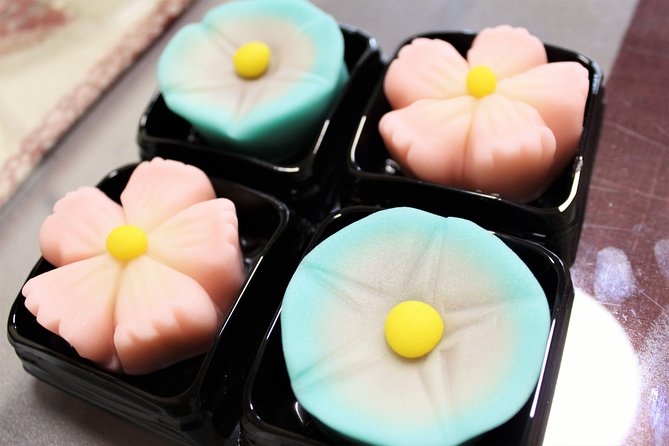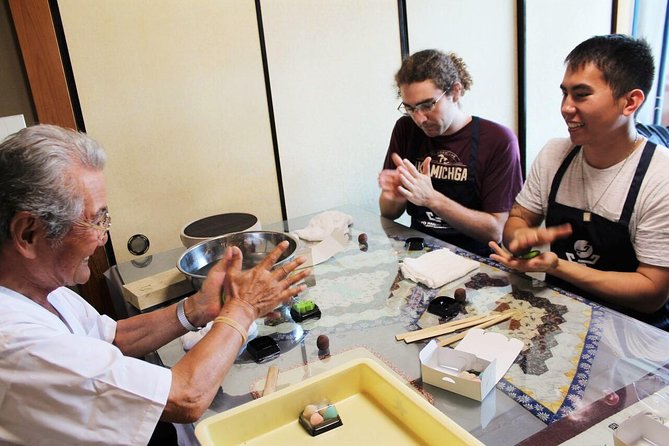Japanese Sweets Making With Seasonal Motifs
In the world of Japanese sweets making, the saying ‘the proof of the pudding is in the eating’ rings especially true. Each confection tells a story, not just through its flavors but also through intricate designs that change with the seasons.
As participants explore this culinary adventure, they will uncover the secrets behind crafting these delicate treats adorned with seasonal motifs. From cherry blossoms in spring to maple leaves in autumn, the art of Japanese sweet-making mirrors the beauty of nature itself.
The allure of mastering this age-old tradition awaits, promising a sensory experience like no other.
Key Points

- Traditional ingredients and techniques reflect Kyoto’s culinary artistry with nerikiri and yokan.
- Tools like Wagashi Mold and Kashigata hold cultural significance in crafting Japanese sweets.
- Seasonal motifs like cherry blossoms and maple leaves enhance the beauty and cultural connections of sweets.
- Japanese sweet-making blends art, tradition, and nature, celebrating the beauty of changing seasons.
Here's some more nearby activities we've reviewed
Ingredients for Japanese Sweets Making

When making Japanese sweets with seasonal motifs, artisans carefully select traditional ingredients to create delicate and flavorful treats that reflect the essence of Kyoto’s culinary artistry.
One of the most popular types of wagashi, traditional Japanese confections, is ‘Nerikiri.’ These sweets are made from white bean paste and are known for their intricate designs that often mimic nature, such as flowers and leaves.
Another well-loved wagashi variety is ‘Yokan,’ a firm jelly-like sweet made from red bean paste, agar, and sugar. These sweets hold cultural significance in Japan, often being offered during tea ceremonies or as gifts to signify respect and gratitude.
The art of crafting wagashi is deeply rooted in Japanese tradition and continues to be cherished for its beauty and symbolism.
Tools Needed for Creating Sweets
Crafting traditional Japanese sweets with seasonal motifs requires specific tools that are essential for shaping and designing the delicate confections. These tools not only aid in the creation process but also hold cultural significance in the art of Japanese sweet making.
Here are three essential tools needed for creating sweets:
-
Wagashi Mold: This traditional wooden or plastic mold helps shape the sweet into intricate designs, reflecting the seasonal motifs like cherry blossoms or maple leaves.
-
Surikogi (Mortar and Pestle): Used for grinding ingredients like sweet beans or rice flour, this tool ensures a smooth texture and authentic taste in the sweets.
-
Kashigata (Sweet Molds): These wooden molds come in various shapes and sizes, allowing for the creation of visually appealing sweets that enhance sweet presentation.
Step-by-Step Guide to Making Sweets
To embark on the journey of creating traditional Japanese sweets with seasonal motifs, one must first gather the essential tools and ingredients in a serene setting conducive to the delicate artistry involved.
Japanese sweet making techniques have been passed down through generations, reflecting a rich history dating back centuries. The process involves meticulous attention to detail and precision, showcasing the cultural significance of these confections.
Understanding the history of Japanese sweets provides insight into the craftsmanship and artistry behind each creation. As one delves into the step-by-step guide of sweet making, they uncover the intricate methods and traditions that make these treats unique.
Importance of Seasonal Motifs in Sweets
Embarking on the art of Japanese sweet making reveals the significance of incorporating seasonal motifs to capture the essence of nature’s beauty in each delicately crafted confection. Japanese sweets, or wagashi, aren’t merely desserts but pieces of art that reflect the changing seasons and celebrate nature’s bounty.
-
Seasonal Symbolism: Cherry blossoms in spring symbolize new beginnings and fleeting beauty.
-
Cultural Significance: Maple leaves in autumn represent the cycle of life, transformation, and reflection.
-
Nature’s Influence: By using ingredients like matcha for spring or chestnuts for winter, these sweets harmonize with the environment.
The practice of infusing wagashi with seasonal motifs not only enhances the flavors but also deepens the cultural connection between the maker, the eater, and the natural world.
Tips for Perfecting Your Sweet Creations
When perfecting your sweet creations, incorporating seasonal ingredients can elevate the flavors and aesthetics of your Japanese sweets to new heights. Experiment with unique flavor combinations such as cherry blossom and matcha, or yuzu and white bean paste, to create a delightful sensory experience.
Plus, mastering presentation techniques is crucial for showcasing the beauty of your sweets. Try using traditional Japanese serving dishes like lacquerware or ceramic plates to enhance the visual appeal. Garnishing with edible flowers or gold leaf can add a touch of elegance to your creations.
Pairing Sweets With Tea or Coffee
Pairing Japanese sweets with tea or coffee enhances the overall sensory experience, allowing the flavors to harmonize and create a delightful balance of sweetness and warmth.
-
Tea Ceremony: Imagine a serene setting with traditional tea utensils where delicate sweets are elegantly paired with a cup of matcha.
-
Flavor Combinations: Picture the subtle sweetness of wagashi complementing the bitter notes of green tea, or the rich flavors of anko paired with a fragrant cup of coffee.
-
Harmonious Blend: Envision the moment when the sweetness of the confectionery dances on your taste buds, perfectly complemented by the soothing warmth of your chosen beverage.
Pairing Japanese sweets with tea or coffee isn’t just about taste; it’s a cultural experience that celebrates the art of harmony in flavors.
Decorating Sweets With Artistic Flair
Enhance the visual appeal of Japanese sweets by adorning them with intricate designs that showcase artistic flair. Japanese confectionery emphasizes not only taste but also aesthetics, with each sweet telling a story through its decoration. Colorful presentation plays a vital role in Japanese sweets, with vibrant hues symbolizing different seasons or occasions. These designs hold cultural significance, often representing nature, festivities, or traditional patterns. To give you a better understanding, here is a table showcasing some common motifs seen in Japanese sweet decorations:
| Motif | Meaning | Example |
|---|---|---|
| Cherry Blossoms | Beauty and renewal | Sakura Mochi |
| Pine Trees | Longevity and strength | Kashiwa Mochi |
| Cranes | Good fortune and longevity | Tsuru Manju |
| Waves | Resilience and adaptability | Mizu Yokan |
These intricate designs not only make the sweets visually appealing but also contribute to the overall cultural experience of enjoying Japanese confectionery.
Preserving and Storing Homemade Japanese Sweets
To properly appreciate the artistry and flavors of Japanese sweets, understanding how to preserve and store homemade confections is integral to maintaining their quality and authenticity. When it comes to sweet preservation techniques and storage solutions, here are three key practices to ensure the longevity of homemade sweets and proper care techniques:
-
Air-tight Containers: Store Japanese sweets in air-tight containers to prevent exposure to air and humidity, which can affect their texture and flavor.
-
Cool, Dark Place: Keep homemade Japanese sweets in a cool, dark place away from direct sunlight to maintain their freshness and prevent melting or spoilage.
-
Avoid Refrigeration: While some sweets may benefit from refrigeration, traditional Japanese confections are best kept at room temperature to preserve their delicate nature.
Here's a few more nearby tours and experiences we have reviewed.
Common questions
Can I Take Home the Sweets I Make During the Class?
Yes, participants can take home the treats they make, creating culinary keepsakes and memories. They can enjoy decorating the sweets and savoring the experience beyond the class, making it a delightful and rewarding activity.
How Long Does the Japanese Sweets Making With Seasonal Motifs Experience Typically Last?
The Japanese Sweets Making with Seasonal Motifs experience typically lasts around 2 hours, including preparation time. Participants explore the cultural significance and symbolism behind each motif while creating these delicate treats under expert guidance.
Are There Any Specific Dietary Restrictions or Allergies That the Instructor Can Accommodate?
For participants with specific dietary preferences or allergies, the instructor can accommodate ingredient substitutions and make necessary accommodations. They strive to ensure everyone can enjoy the Japanese Sweets Making with Seasonal Motifs experience.
Is There an Age Requirement or Limit for Participating in the Class?
There is no specific age requirement for participating in the class. The class duration typically lasts around 2 hours, allowing participants to learn the art of making Japanese sweets with seasonal motifs while enjoying a cultural experience.
Are There Any Special Events or Holidays Where the Seasonal Motifs in the Sweets Are Particularly Significant?
Special events and traditional festivals hold significant importance in showcasing the seasonal motifs of Japanese sweets. These delicacies often reflect the cultural heritage and customs of various celebrations, adding a touch of tradition to the art of confectionery.
Here's more of our most recent tour reviews happening neaby
- Full-Day Private Bamboo Grove and Golden Temple in Kyoto Tour
- Cherry Blossom Family Picnic
- Kyoto & Nara Day Tour From Osaka/Kyoto: Fushimi Inari, Arashiyama
- Kyoto Sweets and Green Tea Making and Town Walk.
- Samurai Sword Experience in Kyoto (Family & Kid Friendly)
- Living Buddhism
- Private Kyoto Tour With Hotel Pick up and Drop off
- Simple Kimono Plan&Gorgeous Kimono Experience
- Kyoto Culture With the Expert: Kimono, Zen, Sake (Wednesdays and Saturdays)
- Sake Tasting in Central Kyoto
- [To Kyoto・Kiyomizu Temple] 3 Minutes on Foot, Yukata (Kimono) Plan. You Can Explore Sightseeing Spots and the Townscape All Day (Return by 5 P.M.)
Last Words
Indulge in the art of Japanese sweet-making with seasonal motifs for a truly unique culinary experience.
Master the delicate techniques under the guidance of a skilled artisan and savor the delicious treats you create.
Enjoy the rich cultural heritage of sweet-making and enjoy the intricate flavors and designs that come with it.
Don’t miss out on this hands-on adventure that will leave you with a newfound appreciation for Japanese confectionery.